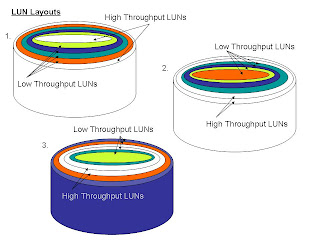
LUN Layout
This diagram shows three different ways in which the same 6 LUNs could be laid out on a RAID Group
In example number 1, the two heavily utilized LUNs have been placed at the beginning and end of the LUNs in the RAID Group, meaning they were the first and last LUNs created on the RAID Group, with lightly utilized LUNs between them. Why this could be a disadvantage to the LUNs, RAID Group, Disks, is that Example 1 would see a much higher rate of Seek Distances at the Disk Level. With a higher Seek Distance rate, comes greater latency, and longer response times for the data. The head has to travel, on average a greater distance between the two busiest LUNs across the disks.
Example 2 has the two heavily utilized LUNs adjacent to each other at the beginning of the RAID Group. While this is the best case scenario for the two busiest LUNs, it could also result in high Seek Distances at the Disk Level because the head would be traveling between the busiest LUNs and then seeking a great distance on the disk when access is needed to the less needed LUNs.
Example 3 shows the heavily utilized LUNs placed in the center of the RAID Group. The advantage to this configuration is the head of the disk would remain between the two busiest LUNs, and then would have a much shorter seek distance to the less utilized LUNs on the outer and inner edge of disks.
The problem with these types of configurations, is that for the most part, it is too late to configure the LUNs in such a way. However, with the use of LUN Migrations in Navisphere, and enough unallocated Disk Space, this could be accomplished while having the LUNs online to the hosts. You will however see an impact on the performance of these LUNs during this Migration process.
But, if performance is an objective, it could be worth it in the long run to make the changes. When LUNs and RAID Groups are initially configured, we usually don’t know what type of Throughput to expect. After monitoring and using Navisphere Analyzer, we could at a later time, begin to move LUNs with heavier needs off of the same Raid Groups, and onto Raid Groups with LUNs not so heavily accessed.
7 comments:
how does this work with a metalun?
it's the same concept...remember the metalun is just made up of component luns...so where those component luns are on the raid group and what other luns are on them as well, can impact the entire metalun
thx!
so, when creating a metalun, we should keep in mind what order we create the luns on each raid group that will be included in the metalun?
e.g. data metalun should be lun1 on raid groups 1,2,3. Not lun1 on raid groups 1,2 and lun3 on rg3?
thx again!
San Guy -- Help me out here I'm new to SAN environments.
Are you stating that when creating RAID Groups and LUN IDs, the numbers matter? They actually determine the placement of your data?
OR
Are you stating that when creating a single RAID Group w/ 6 LUNS; LUNS 2 and 3 are the most efficient and 0 and 5 are the least? See bellow.
RAID GROUP 0
- LUN 0 [Least Efficient]
- LUN 1
- LUN 2 [Most Efficient]
- LUN 3 [Most Efficient]
- LUN 4
- LUN 5 [Least Efficient]
Thanks.
Joel,
Yes it does matter where the LUN is on the Raid Group for the entire MetaLUN. Because each LUN for a MetaLUN is a Component LUN, if there are other LUNs on the Raid Group, the Disk is going to have to seek back and forth for the data, therefore adding latency. So, you could argue that all of the Component LUNs on the MetaLUN would be the first LUNs on each RAID Group, thereby being the fastest LUNs on each RAID Group. Or, if there are other LUNs, then perhaps having your Component LUNs be in the middle of the RAID Groups.
Todd,
The second statement is true. LUN numbers mean nothing in terms of LUN placement. It is all about the order in which they were created. And instead of using the words "Less Efficient," let's say "Less Utilized."
Thanks so much for taking your time to create this very useful and informative site. I am always looking for a site about wedding dresses ,now,I've found it.I have learned a lot from your site. Thanks!! I think you have done an excellent job with your site. I will return in the near future.
Post a Comment